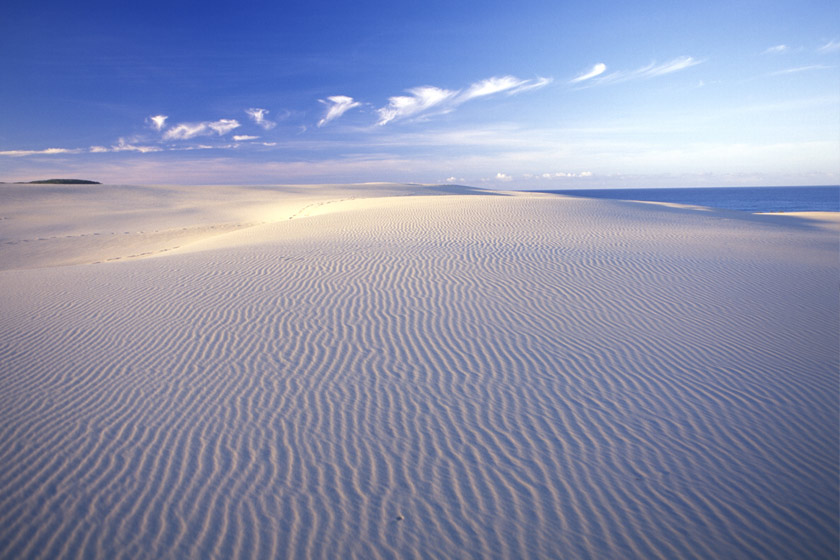There are many interesting questions and facts about Queensland’s Fraser Island, below are some of the most commonly asked questions.
- Fact: Fraser Island is the largest sand island in the world measuring 120km by 15km.
- Fact: Formed during the Ice Age, Fraser Island is the largest stretch of sandy land that lies along the coast of Australia.
- Fact: This Heritage-Listed island measures approximately 1840 square kilometers, making it the biggest sand island in the world.
- Fact: Because it has a maximum elevation of 244m, Fraser Island offers magnificent views over its glorious sand dunes, peat and wallum swamps, mangrove forests and eucalyptus woodlands.
Learn more about Fraser Island.
Fraser Island got its name from Eliza Fraser, a Scottish woman who was the wife of the captain of the ill-fated ship, Stirling Castle that shipwrecked on the island. Fraser Island is known as K’Gari (paradise) to the Aborigines.
Learn more about the History of Fraser Island.
How was Fraser Island formed?
- Fact: The island was created over hundreds of thousands of years from sand drifting off the east coast of mainland Australia.
- Fact: Fraser Island took more than 800,000 years to develop. In fact, its sand dunes are still developing.
One of the lesser known facts is that the sand found on Fraser Island actually originates from New South Wales’ tablelands, where the currents pushed them up North. According to geologists, three different rocks called Waddy Point, Middle Point and Indian Head acted as anchors and consequently gathered the sand around their bases.

There was a time when Fraser Island formed part of the mainland, but it became an island around 20,000 years ago prior to earth’s last ice age. This was also a result of rising sea levels. According to the experts, the sand dunes are a result of the omnipresent easterly winds.
Consequently, some of Fraser Island’s sand dunes such as Mt. Bowarrady are among the tallest in the world, towering at 240 meters.
It is interesting to know that Fraser Island contains purer sand than the Sahara dessert.
Along with its large expanses of silica sand, Fraser Island is also made up of what’s colloquially referred to as coffee sand or coffee rock.
Because of the organic colloids that are prominent on the island, the sand has been cemented together and compacted, resulting in brownish rocks.
While coffee rocks are visible all over Fraser Island, most of these formations are found across the beach.
Where is Fraser Island?
Fraser Island is found 300km north of Brisbane, along the southern coast of Queensland in Australia.
Because of its location, visitors can bask in the delicious sunlight and clear, sparkling water all year round. It is also quite accessible from Australia, whether you choose to go by ferry, train, road or helicopter.
Learn more about how to get to Fraser Island.
Fun & Interesting Fraser Island Facts
- Fraser Island is the only place in the world where the rainforest grows on sand
- The island is home to a profusion of bird life and wildlife including the purest strain of dingo in Australia
- Fraser Island is home to striking blue freshwater lakes, crystalline creeks, giant dunes and lush rainforests
- The vegetation varies from dense tropical rainforest and wild heath to wetlands and wallum scrub
- Over 350,000 people visit the island each year making Fraser Island feel like a congested beach highway sometimes
- Fraser Island joined the World Heritage list in 1992
- The northern half of the island is protected as the Great Sandy National Park while the rest consists of state forest, crown land and private land
- A 4WD is necessary to drive on Fraser Island
- You will need permits for vehicles and camping on Fraser Island, and these must be purchased before you arrive
Teeming with wildlife and nature, Fraser Island has quickly established itself as one of the most striking tourist spots in Australia- and for good reason. With white silica beaches and delectable shafts of sunlight, this island is especially reputed for its excellent camping spots, especially around its numerous lakes.
Best of all, it is quite easy to get to Fraser Island, thanks to the daily rail and ferry services.
A lesser-known fact about this island is that several of its structures were formed from deposits carried over from the New South Wales area by powerful waves and winds. Fraser Island is also known for its multiple dune and perched lakes. With a humid and pleasantly hot climate, this island has an average temperature of 15 degrees in the winter and 30 degrees in the summer.
Best of all, the island is packed with no less than 25 different species of mammals including dingos, echidnas, flying foxes, possums and wallabies.





